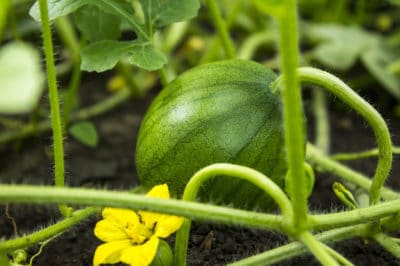Getting the Best Start
Watermelons are a warm-season crop that performs best when outdoor temperatures are consistently warm and there’s no longer a threat of frost. Plants are very sensitive to cold temperatures and if you plant transplants or seeds too early they may fail to thrive or germinate.
However, you can start seeds indoors several weeks before warm weather arrives by planting in peat pots and placing them in a warm and sunny location. Once outdoor temperatures warm, you can plant the entire peat pot into the garden without the threat of disturbing the melon’s sensitive root system.
Using Green Manure Cover Crops
You can increase your soil’s fertility and nitrogen levels organically before planting by growing green manure cover crops in the area prior to planting the watermelon transplants or seeds. Plant the crops in early fall and mow down before you plant the melons in spring. Some good green manure cover crops include:
- Austrian Winter Pea
- Crimson Clover
Expert Gardener Tips: Rotating your watermelon plants by planting in an area where you grew legume plants the previous year assures the melons receive a healthy dose of nitrogen left behind in the soil.
Prepping the Soil for Planting
Watermelons thrive in a sunny location planted in soil that drains well and is rich in organic nutrients. Soil with a pH of 6 to 6.5 is suitable. You can prepare the garden bed weeks before you plant so the area is ready to receive the transplants or seeds.
- Remove any unwanted weeds or grasses from the area. Unwanted growth robs the developing watermelon plants of moisture and nutrients.
- Spread an approximate 6- to 8-inch layer of well-rotted compost or well-rotted cow manure over the planting site.
- Work the organic material into the soil about 6 inches.
Expert Gardener Warnings: Use caution if you consider using chicken manure, especially if it’s “straight” and not composted. Chicken manure is strong and hot and can burn plants. The manure can also contain salmonella, which can transfer food poisoning to fresh vegetables including watermelons. Since the manure easily washes from the planting site, there’s the risk of it polluting nearby water sources.
Continued Feeding
Watermelon plants require different nutrients depending on the plant’s stage of growth. It’s important not to apply high amounts of nitrogen once the plant sets fruit. Too much nitrogen at this stage produces lush leafy growth over the production of fruits.
Always follow label instructions for the particular fertilizer you are using concerning proper application procedures and amounts.
- Use a liquid seaweed fertilizer sprayed on plants once germination and flowering occurs. During mid-summer when temperatures are extremely hot, the watermelon plant’s foliage may have a tendency to yellow and applying the liquid seaweed fertilizer helps correct this problem.
- About a month after planting and just as the watermelon plants begin to run, apply another dose of organic nitrogen such as worm castings or blood meal. When applying blood meal, side dress the product at least 6 inches away from the plants and gently work into the soil and water well. Liquid worm castings can be sprayed directly on plants.
- Once the fruit has set and the watermelons begin growing, side dress with an organic product containing phosphorus and potassium such as greensand and rock phosphate.
Expert Gardener Tip: If granular products get on the watermelon plant’s foliage, be sure to wash it off with water to prevent burning. Always water these types of products into the soil after application.
